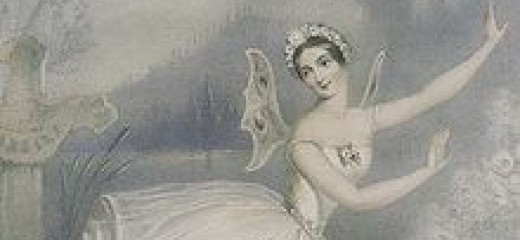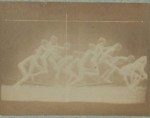
Critical Moments: Four Centuries of Dance Journalism
By Lynn Matluck Brooks
[Image on homepage: Fanny Elssler in "La Cachucha"]
How has stage dance been reported, evaluated, and recorded in periodicals like newspapers and magazines over the course of time? What have been reviewers’ focuses and concerns as they responded to this art of fleet feet in ever-transforming styles and genres? Here’s a bird’s-eye view of distinct and revealing moments I encountered investigating these questions in commentaries from the eighteenth century to the present, from England, France, and the United States.
1709
The playwrights and essayists Joseph Addison and Richard Steele published a series of periodicals that reviewed the eighteenth-century London cultural scene. In the Spectator, the Tatler, and the Guardian they commented on politics, society, and, occasionally, theater and dance. The dance-related writing is rich in description; in the May 3, 1709, Tatler, Steele vividly reported (and interpreted) a dance he observed in the show “Modern Prophets” by Thomas D’Urfrey. It “represented absolute power, in the person of a tall man with a hat and feather.” This dancer
… gives his first minister, that stands just before him, a huge kick: the minister gives the kick to the next before; and so to the end of the stage. In this moral and practical jest, you are made to understand, that there is, in an absolute government, no gratification, but giving the kick you receive from one above you to one below you. This is performed to a grave and melancholy air; but on a sudden the tune moves quicker, and the whole company fall into a circle and take hands; then, at a certain sharp note, they move round, and kick as kick can. This latter performance he makes to be the representation of a free state; where, if you all mind your steps, you may go round and round very jollily, with a motion pleasant to yourselves and those you dance with.
For Steele, dance told stories, revealed characters, and expressed philosophies. Three years later, in the Spectator, he wrote, “it would be a great Improvement, as well as Embellishment to the Theatre, if Dancing were more regarded, and taught to all the Actors.” He praised actress-dancer Mrs. Bicknell for her “Capacity of Imitation” whereby she represented “in proper Gesture and Motion … all the decent Characters of Female Life. An amiable Modesty in one Aspect, … an assumed Confidence in another, a sudden Joy in another, … a Return towards the Audience with an unsteady Resolution to approach them, and a well-acted Sollicitude to please.” Steele’s concern lay not in technical virtuosity but in the drama, character, and moral implications of movement expression.
1842
Over a century later, and across the channel, we encounter the height of the Romantic ballet, championed journalistically by poet, novelist, and critic Théophile Gautier. He loved the ballet and, more so, its ballerinas, while he typically abhorred male dancers. He occasionally described plots and movement, but his greatest interest lay in appraising dancers’ expressive physicality. In a June, 1842, review in La Presse, Gautier rhapsodized the great Carlotta Grisi as
… the very incarnation of the aerial dancer whom the poet imagined descending and mounting a crystal stairway of melody in a glow of sonorous light. She reaches, without a falter, the uppermost rung of the ladder of silver filigree that the musician has constructed as if to defy her lightness…. It is quite impossible to dance with greater perfection or more strength and grace, a more profound sense of rhythm and timing, or a happier and sunnier expression. She betrays no fatigue, no effort; there is no sign of perspiration or breathlessness.
His allusions to musicality, movement qualities, aesthetic values, and individual expression reveal his connoisseurship. Similarly, in a review published in La Charte in April, 1837, Gautier disclosed more of his own taste than of the dancer’s steps or gestures:
You know what a hideous sight an ordinary male dancer is—a great awkward creature with a long red neck swelling with muscles, a stereotyped grin that is as irremovable as a judge, … the thick calves of a parish beadle, arms like carriage shafts, and then the great angular movements with elbows and feet placed at right angles, the airs of Adonis …, and the ronds de jambe, pirouettes, and other gestures of mechanical puppets.
Yet these prejudices did not blind him to quality, for Gautier went on, “The dancing of Sr. Camprubí [a Spanish escuela bolera dancer performing in Paris] is as pleasing a sight as that of a woman, yet he preserves a heroic and gentlemanly expression in his poses that has nothing in common with the foolish affectation of French male dancers.”
Nor did all women meet Gautier’s standards. Of the unfortunate Louise Fitzjames, he suggested that, rather than dancing the role of a bayadere, as she was cast in November, 1837, she “would be very well cast as an asparagus in a ballet of vegetables,” lacking as she did the dancer’s essential attribute: “a body which, if not perfect, is at least graceful. Mlle. Fitzjames has no body at all.” Further, “Dancing is essentially pagan, materialistic and sensual…. Fitzjames’ arms are really too spiritualistic and her legs too aesthetic.” In contrast, Fanny Elssler “is the most beautiful of all women appearing on the stage today…. What is fascinating about her is the perfect harmony of her head and her body. She possesses hands that match her arms, feet that match her legs, and shoulders that are indeed the very shoulders for her torso. In a word, she is all of a piece” (May 1838). Physical beauty, and its effect streaming across the footlights to the audience—this is what captivated Gautier in the nineteenth century. In an age of theater cliques and clacquers, raucous audience response, and lengthy exchanges about theater in newspapers and periodicals—as well as the free-market pressure on theaters recently cut off from royal support (and control)—such pronouncements were truly “critical” to a performer’s career.
1928
Not a hundred years passed before dancers were embracing an aesthetic in express rejection of Gautier’s romantic world. By the 1920s in the U. S., the sports writers, drama reviewers, and music appreciators, who had earlier been assigned to dance coverage, were supplanted by dedicated dance critics. One of these, John Martin, came from a theater background but was assigned by the New York Times to cover dance because no one else wanted the job. He soon positioned himself as advocate and interpreter for the public, whom he felt he must educate to grasp the emerging modern dance scene and its visionary artists. As early as April, 1928, he wrote, “This oldest of all the arts began some time ago to tire of its chronic condition of arrested development and decided to grow up; decided it with such vigor and purpose, in fact, that its present state of progress is worthy to be dignified with the name of a renaissance.” This rebirth of dancing he viewed “in the light of its relation to other phases of present-day change and development,” particularly “art, athletics, and the liberalizing social standards.”
Yet, in November of that year, Martin lamented, “With all the activity that is evident in the dance world, … it is strange that so little thought seems to have been given to the subject of teaching the layman,” a practice he called “common” in other arts. He noted that concert dance audiences for such artists as Martha Graham, Doris Humphrey, and Tamiris were, at that time, “specialized” and excluded the layman who might, naively, insist a dance needed to have a story or be “beautiful” in some conventional way. Instead, viewers must learn, Martin insisted, that, “The substance of a dance consists of its revelation of some measure of the universal through the medium of the particular. If this revelation must be interpreted and re-expressed in words, then words should have been its particular medium in the first place.” Verbal language satisfied the domains of “ideas, tangible intellectual concepts, propaganda, moral doctrine,” but dance “utilizes less forthright means, such as feeling and intuitive perception, on which to base contact with the transcendental truths it embodies.” This kind of emotional, sensory perception “conveys itself only by experience,” rather than through verbal description. If the layman were initiated into this kind of appreciation, modern dance audiences would grow.
Martin set himself up as educator not only to the audiences about the dance, but also to the dancers about the audience. In a May, 1930, review he warned modern choreographers against regarding their audiences “as morons to be catered to at the lowest possible level or as so many potential esthetic experts waiting to be initiated into the mysteries.” Martin continued as a Times criticuntil 1962, expanding his interest to ballet, publishing books on dance, and establishing himself on the lecture circuit—all forums for his pedagogical mission.
2012
Hopping forward nearly another century, we land at today’s dance criticism; thINKingDANCE, a forum on which I write, characterizes the craft in the twenty-first century. This electronic periodical has had an impact on the local (and broader) dance scene, covering a wide range of dance and raising important questions about the field. Its goals, processes, and essays have been praised by leading writers with whom we have worked; and those of us involved in the project have experienced considerable evolution as writers, thinkers, and dancers. Like other dance-review sites, thINKingDANCE is public, free to readers, and invites responses, but it is also self-reflective and integrated variously into the community on which it comments. It works “to catalyze conversation about dance and to develop the skills of dance writers” through “peer critique” and “dialogue” that invites the public (artists, audience members, and readers) to “weigh in” on the essays and the ideas these raise. In some cases, the site features reviews of one program by multiple writers, each essay allowing a different take on that work. One or two articles have generated as many as 30 responses, other articles none, but all remain available for reference, review, and response. At thINKingDANCE and other electronic dance-criticism sites, inherited journalistic standards are in question as well as in conversation with readers’ responses and with writers’ awareness of powerful cultural shifts in the ground we tread.
As a long-time writer and teacher, I am impressed by the quality of thought and writing I encounter as we sit around the thINKingDANCE table sharing our work, and as I read new articles on the site. I won’t quote the writers here, as I have above. Instead, I suggest you pull up the archive and pick—randomly or directed by your own curiosities—an article or two. And, please, comment. You, too, are a part of twenty-first century dance criticism.
By Lynn Matluck Brooks
August 8, 2012








